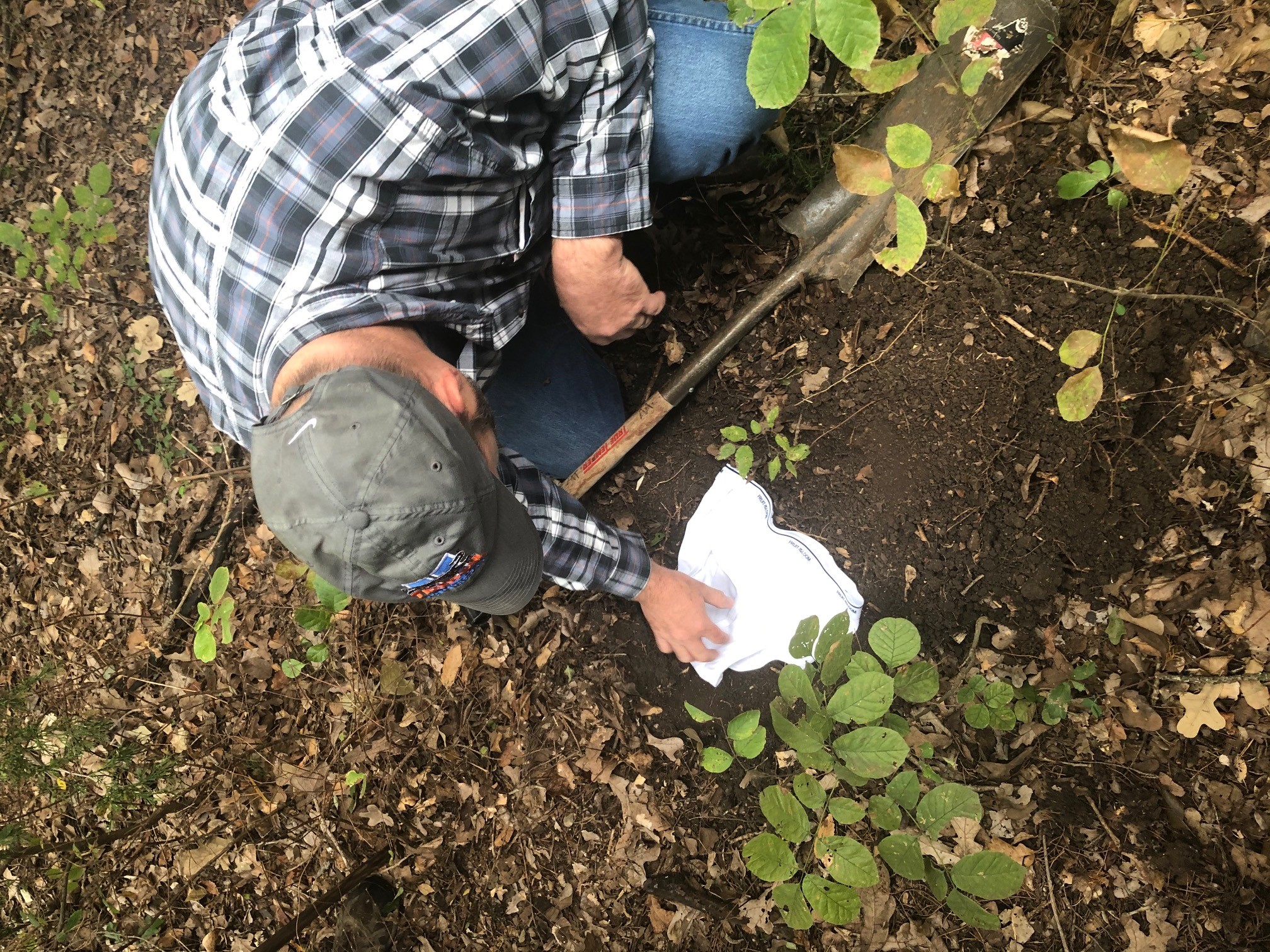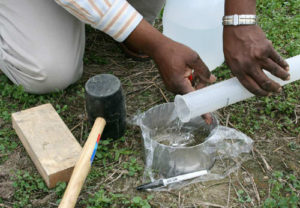Get to know your soil and your soil health

“Soil your undies” is a fun way to observe how alive your soil is. First “plant” a pair of new cotton underwear in your orchard. Wait at least 60 days and dig them back up. The more the undies are deteriorated, the healthier your soil. (Photo by Photo courtesy of Noble Research Institute)
But I wonder, how many of you can do the same when it comes to the soil beneath your trees? The soil is the foundation of life for our orchards, and for so many of us, it is simply what the tree is growing in. We do not give it a lot of thought, especially after an orchard is established.
Soil is a living ecosystem. Healthy, vibrant soil has by far more life below ground than above. There are more microbes in a teaspoon of soil than there are people on earth. Soils normally contain about 8 to 15 tons of bacteria, fungi, protozoa, nematodes, earthworms, and arthropods.
So as a grower, how can you monitor and scout your soils to determine soil health? There are soil tests that can analyze overall soil health—for example, the Haney test. The Haney test goes beyond a traditional soil test to evaluate how biologically active, or alive, the soil is. Also, the Phospholipid fatty acid (PLFA) test can be used to give you critical information about the soil’s microbial populations. In addition, there are evaluations you can make about the soils within your orchards to help you determine how healthy the soils are. Most of these evaluations can be done with your observation and a shovel.
Simple observations to evaluate soil health:
Above the soil:
Soil Cover—Having the soil covered is a significant factor in promoting soil health. Covered soils help reduce erosion, reduce soil temperatures, and provide a food source for microbial growth.
Residue Breakdown—How fast the residue is decomposing on the surface can indicate biological activity. Knowing if your residue is young (brown in color) or old (gray or black in color) can help you determine if the microorganisms and insects are breaking down the residue (brown) or if the residue is being chemically broken down through oxidation (gray or black). We want the residue to be broken down by microorganisms to allow the nutrients to go into the ground and help increase organic matter. If the residue is breaking down chemically, the nutrients are being lost into the atmosphere and not returning to the soil.

Measuring water infiltration rate in your orchard. Use a metal ring (can be made from coffee can or pipe) that is 6 inches in diameter; then drive the ring into the soil about 3 inches deep using a sledge hammer and wooden block. Gently press along the inside of the ring to ensure the soil is in direct contact with the side of the ring. Next, place a piece of plastic wrap, large enough to cover the soil surface inside the ring. Add 16 ounces of water (equivalent to 1 inch of water in 6 inch diameter ring) on top of the plastic wrap. Remove plastic wrap and start your stopwatch. Record the time it takes for one inch of water to infiltrate into the soil. An infiltration rate of 1 to 2 inches per hour is considered ideal. (Photo by USDA Natural Resources Conservation Service)
Water Infiltration—After a typical rainfall or irrigation event, is there ponding of water on the surface? Ponding is a result of surface crusting, low water infiltration, and perhaps low organic matter. To truly evaluate the water infiltration of your soil, you can do a water infiltration test to determine how quickly the soil takes up water (rainfall or irrigation). Typically, the faster the water is taken up by the soil, the better.
Biological Diversity—How much biological diversity do you see above the soil? Do you have insects, animals (small and/or large), birds, and/or other living things? Do you have a variety of different grasses, legumes, and/or forbs under the trees? Diversity is key to increasing soil health. Each type of forage (grass, legumes, and forbs) secretes different exudates from their roots that help feed the microorganisms in the soil.
Below the soil surface:
Five soil health indicators:
- Soil color—The darker the soil, the higher the organic matter content. Soil organic matter and soil organic carbon are the primary drivers in biologically active soil systems.
- Soil structure—Structure often determines the amount of pore space between particles. The more pore space, the greater the water infiltration. Soil aggregation is also important and as soil organic matter increases, so does aggregate stability.
- Presence of biological activity—Healthy soils are biologically active soils. Essentially, we refer to the presence of earthworms, earthworm castings, dung beetles, etc., or evidence of their activity.
- Rooting resistance—Look for evidence of layers of resistance. Platy structure or horizontal layers are common signs of compaction and limit root penetration and water infiltration.
- Soil Smell—Healthy soil should have an earthy smell. The earthy smell comes from geosmin, which is an organic product produced by active soil bacteria. If your soil smells different than this, there is a problem that needs addressed.
As pecan growers, we need to start thinking about the total system we work with, not just the trees. We have to start thinking about the causes of the problems that we see in our orchards. For so long, we have been taught to apply another input to help alleviate the problem and have not been taught to focus on the root of the problem. When we use these inputs to alleviate (or cover up) the problem, we are just using a band-aid and not identifying the real issue at hand. Improving our soils’ health is a great first step. This will increase the health of our crop and help us address the problems that we are having. At the same time, it may potentially reduce our input costs while growing pecans.

